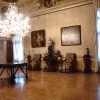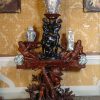As we have seen in the ballroom, the ‘decorative furniture’ carved by Andrea Brustolon for the Venier family is considered the greatest masterpiece of early 18th-century Venetian carving. The most famous piece is certainly the console-cumvase- stand on the right wall of this room, at the bottom of which we see Hercules, the vanquisher of the Lernian Hydra, with Cerberus at his feet. On its shoulders Cerberus bears the upper surface, which is worked like a rough tree trunk, and shows three ebony blackamoors in chains holding up a large vase. At the two sides lie two bearded old men, each holding another two vases. An identical, exceptional skilful inventiveness also appears in the splendid series of vase-stands with the allegories of the Four Seasons, the Four elements and Apollo symbolising the light. The extraordinary care which went into the making of these furnishings reveals the high consideration and above all the value of the series of oriental (Chinese and Japanese) vases in Pietro Venier’s collection. It was for these that these precious, original stands were designed.
The ceiling decoration consists of eleven canvases of different shapes and sizes which come, like the five now in the previous room, from Palazzo Nani at Cannaregio, and are again the work of Francesco Maffei. In this case, identification of the extremely heterogeneous subjects is complex and inevitably to a certain extent unreliable. In the centre is the oval with Jove; around him, starting with the naked figure with a bunch of flowers representing The Sense of Smell and moving clockwise we see: Mercury, Apollo, Saturn, The Sense of Touch, Mars, Diana. Near the walls on the long sides are: The Sense of Hearing and Minerva as Divine Wisdom. The four monochrome tondos in the corners of the ceiling showing the Four Continents are by a different artist. They too come from a ceiling in Palazzo Nani but were painted over a century later by Francesco Polazzo.
In the centre of the room hangs the superb crystal glass chandelier with its two rows of 20 candle-holders and brightlycoloured glass paste flowers. This was produced towards the mid-18th century by the Murano factory of Giuseppe Briati, and is certainly the most extraordinary example of its kind to have come down to us intact.


